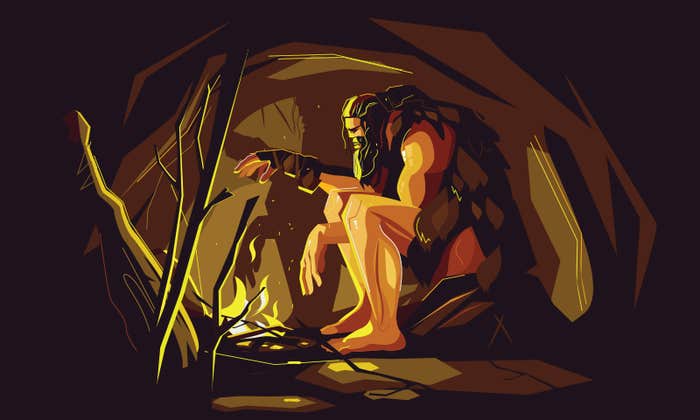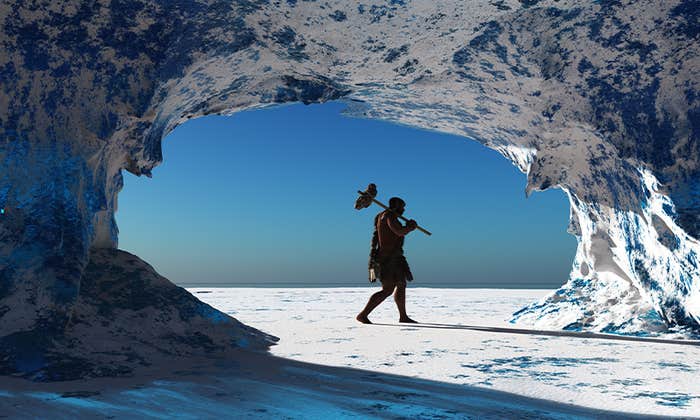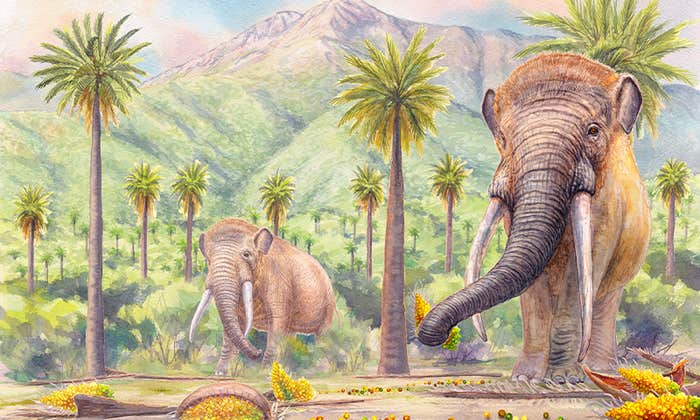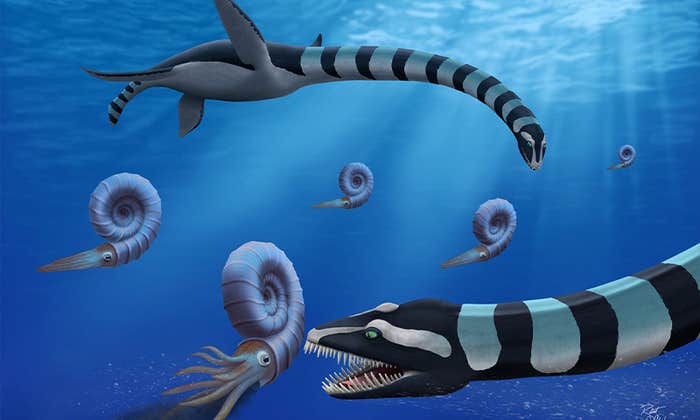In May 1997, the same month that The Lost World: Jurassic Park debuted in the United States, the U.S. Postal Service released 15 gorgeous stamps depicting various dinosaurs and extinct reptiles. The stamps caused a sensation among dino enthusiasts and paleontologists alike. “We all rushed out to get them,” remembers Christopher Brochu, a paleontologist at the University of Iowa. As an expert on crocodiles and their ancestors (known collectively as crocodilians and crocodyliforms), Brochu was particularly ecstatic to see that one stamp featured Goniopholis, a crocodyliform from the late Jurassic. When he looked closer, however, he noticed a few oddities: The checkers on its tail, the shape of its scales, and the arrangement of its teeth were not quite right. This drawing, Brochu realized, was not based on fossils of Goniopholis, but rather on the contemporary Nile crocodile.
“People think that to make a landscape look primeval, all you need to do is throw a crocodile into the mix—even a modern one,” Brochu says. “There’s this idea that crocodiles haven’t changed at all since the time of the dinosaurs, that they are so-called ‘living fossils.’ ” It’s a notion that’s often repeated in magazines, museums, and nature documentaries. But it’s completely wrong. In fact, the whole concept of a “living fossil” has fallen apart.
Charles Darwin coined the term “living fossil” in The Origin of Species to describe some of the planet’s more ambiguous creatures—such as the lungfish and platypus—that evolved relatively early and “endured to the present day.” He saw these animals as living proof of the evolutionary transitions between, say, ocean-dwellers and amphibians. Darwin was careful to point out that this phrase was “fanciful,” but it was also poetic and memorable. It quickly multiplied in both academic writing and the popular press. Eventually, it came to signify creatures that had emerged long ago and had not changed for eons, preserving a primitive appearance unlike any other living thing. “Living fossil” was no longer a passing phrase; it had become a powerful concept shaping scientists’ attitudes toward modern species. If certain creatures were frozen in evolutionary time, the reasoning went, then they could be our windows to ancient epochs of life.
There was a habit of saying, ‘Oh, this fossil looks like a crocodile, let’s just put it in a drawer.’
The idea of the living fossil persists today in everything from top-10 lists of weird creatures to recent scientific studies. The only trouble is this: There is no such thing as a living fossil. It’s true that the living descendants of early animal lineages can teach us about their ancestors, but the idea that any species alive today has stopped evolving is simply false. In the last 10 years, scientists have liberated numerous species from this evolutionary straitjacket, including coelacanths, horseshoe crabs, cycads, lizard-like tuataras, and tadpole shrimp. Among them, perhaps no “living fossil” has been as dramatically redeemed as the crocodile.
Early paleontologists noted the strong resemblance between certain ancient crocodilians and modern crocodiles. By the early 1800s, however, researchers had also unearthed fossilized crocodiles that clearly differed from living ones in subtle but important ways. Some scientists downplayed these distinctions because they contradicted the then prevailing belief: Species did not change over time. Many of these scientists were Christians who accepted, as the Bible dictated, that all life sprung from divine creation—that all creatures were and always had been as God made them. In 1836, William Buckland, the theologian and pioneering paleontologist, wrote, “fossil reptiles of the Crocodilean family do not deviate sufficiently from living genera to require any description of peculiar and discontinued contrivances.” Buckland was essentially saying that crocodiles “hadn’t changed and there was no point studying them,” explains Brochu.
In the late 19th century, these attitudes melded with the increasingly popular notion of living fossils—a phrase that seemed to perfectly describe crocodiles. Paleontologists well into the mid-20th century assumed that both ancestral crocodiles and modern ones fit the same biological template: They were all scaly, partially aquatic ambush predators averaging 10 feet in length with flat broad snouts and conical unserrated teeth. Fossil crocodilians were not neglected, but they were not lavished with close inspection either. “There was a habit of saying, ‘Oh, this fossil looks like a crocodile, let’s just put it in a drawer,’ ” explains Alan Turner, an expert on fossil crocodylians and their ancestors at Stony Brook University.
The living theory of crocodiles have overestimated their evolutionary age by about a factor of 10.
Things started to change in the 1980s. New fossil discoveries, more sophisticated methods of classifying fossils, and cutting-edge molecular analysis of living species revived interest in the evolutionary history of crocodilians, and overturned longstanding notions. Brochu began to meticulously examine crocodilian fossils from around the world, categorizing and comparing their tiniest features in giant matrices in order to determine evolutionary relationships. The more closely he looked, the more obvious it became that earlier paleontologists had misunderstood the evolutionary trajectory of crocodiles. He discovered that many fossils labeled crocodyliform because they looked vaguely similar to modern crocodiles were actually more distantly related reptiles. The true crocodyliform family was far more varied than had been acknowledged, both in appearance and lifestyle: “I began to realize there was a lot of underappreciated diversity,” he says.
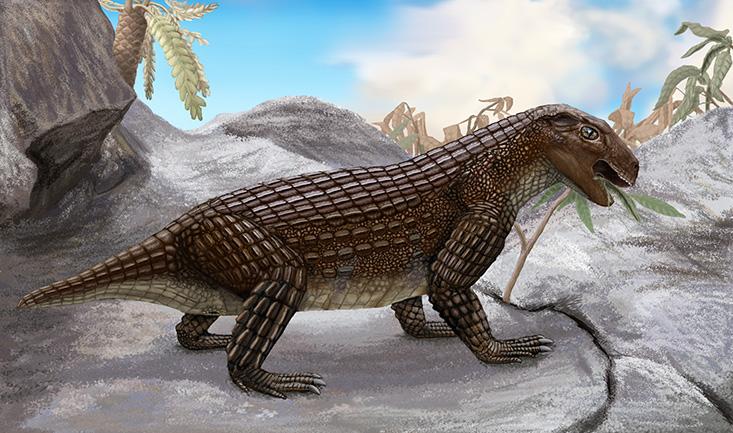
By scrutinizing understudied and recently uncovered fossils, Brochu and other paleontologists demonstrated that ancient crocodyliforms were not just slight variations on our modern conception of “crocodile,” perhaps best embodied by the Lacoste logo. Crocodiles were once as diverse as dinosaurs. In fact, the ancestors of crocodiles were the most varied and dominant animals on the planet until a mysterious catastrophe about 200 million years ago killed many of them off, allowing dinosaurs to rise to prominence. The crocs that survived continued to thrive and diversify, rebounding once again after the asteroid impact that wiped out all dinosaurs except birds 66 million years ago.
Around the same time that Brochu and other paleontologists ushered in new recognition of the diversity of crocodile ancestors, a separate line of evidence was changing scientists’ minds about when exactly contemporary crocodilians—crocodiles, caimans, alligators, and gharials—first evolved. Like all living fossils, crocodiles were thought to have emerged in the distant past and then stayed largely unchanged. The standard theory held that the crocodilian species we know today originated in Africa during the Cretaceous (145 to 66 million years ago), when the seven continents were much closer together. As the continents drifted apart, the crocodilians went with them, explaining how they ended up in a band of tropics encircling the globe. If that were true, then modern crocodilian species should be very different from one another at the level of genes and molecules, because there would have been more than enough time for substantial mutations to accumulate. By the 1990s, however, molecular analysis revealed that immune system molecules conserved across living crocodilian species were remarkably similar in structure and behavior.
Could these tame crocs be an entirely distinct species?
Intrigued by this puzzle, a post-doctoral research fellow at the University of Washington named Jamie Oaks began collecting DNA samples from all 23 living crocodilian species, comparing sections of the genome where mutations were most likely to have appeared. Although the fossil record had confirmed that ancient crocodilians were more diverse than previously realized, it also demonstrated that, on the whole, crocodilians were not particularly swift evolvers compared to mammals and other vertebrates. Even accounting for this slower-than-average evolution, Oaks did not find nearly as many differences between the modern crocodilian genomes as one would expect had those species diverged all the way back in the Cretaceous. He concluded that modern crocodilian species split from their last common ancestor between 8 and 13 million years ago, not long before ancient hominins split from their last common ancestor with chimpanzees. The living fossil theory of crocodiles had overestimated their evolutionary age by about a factor of 10.
Oaks also noticed something odd about the DNA samples he had acquired from the iconic Nile crocodiles (Crocodylus niloticus): they did not match up with each other. In fact, the variation between them was great enough to suggest that he was looking at two distinct species. If so, then not only were modern crocodiles much too young to be living fossils, but they had also continued to speciate after diverging from their basal ancestor—something living fossils are not supposed to do. On its own, Oaks’ study was intriguing, but not enough to convince the larger scientific community to cleave the Nile crocodile into two species.
Unbeknownst to him, however, a separate team of scientists was preparing to corroborate his results. In the early 2000s, on an excursion to Chad, the wildlife conservationist Michael Klemens encountered some odd little crocodiles in a desert oasis. They were so docile that he and his companions could swim beside them without concern. He took a tissue sample from one that had recently perished and sent it to the American Museum of Natural History in New York City, where Evon Hekkala, an assistant professor at Fordham University studying crocodilian diversity, sequenced its genome. When she compared the docile croc’s DNA to other Nile crocodiles, she noticed some rather striking differences. She found similar reports of tame crocodiles in Mauritania, and she remembered once reading a description by the Greek historian Herodotus of ancient Egyptians using mellow crocodiles in temple rituals. Could these tame crocs be an entirely distinct species?
A once marvelously motley tribe of reptiles—of swimmers, sprinters, and tree-climbers, of the lizardy, cat-like, and pug-nosed—had dwindled to a handful of survivors.
DNA analysis of 123 African crocodiles—as well as 57 separate samples from museum specimens, including crocodiles mummified in ancient Egypt—confirmed her suspicion. In a few sections of their respective genomes, all the mild-mannered crocs would have one DNA sequence, and all the typical Nile crocs another. They even had different numbers of chromosomes. “That made us very confident that there were actually two different populations and they were not mixing their DNA,” Hekkala says. The two different species had diverged between 3 and 6 million years ago: Crocodylus niloticus in the East and the smaller, less aggressive Crocodylus suchus in the West. The vast majority of mummified crocodiles were C. suchus, suggesting that ancient Egyptians had recognized the difference.
Together, Hekkala, Oaks, and other scientists helped redraw the map of how crocodilians evolved in space and time, and conclusively removed them from the category of living fossils. As the fossil record had already shown, crocodilians survived a particularly severe mass extinction around 15 million years ago, during a period of dramatic cooling and expansion of glacial sheets. By this point, a once marvelously motley tribe of reptiles—of swimmers, sprinters, and tree-climbers, of the lizardy, cat-like, and pug-nosed—had dwindled to a handful of survivors. Those fortunate few colonized tropics around the world, most likely by embarking on epic ocean journeys (just as birds coast on thermals, saving their energy, modern saltwater crocodiles surf the currents to travel hundreds of miles with minimal effort). The new DNA evidence indicated that, within the last 13 million years, the globetrotting descendants of the last remaining crocodilians evolved into the 24 modern species we recognize today.
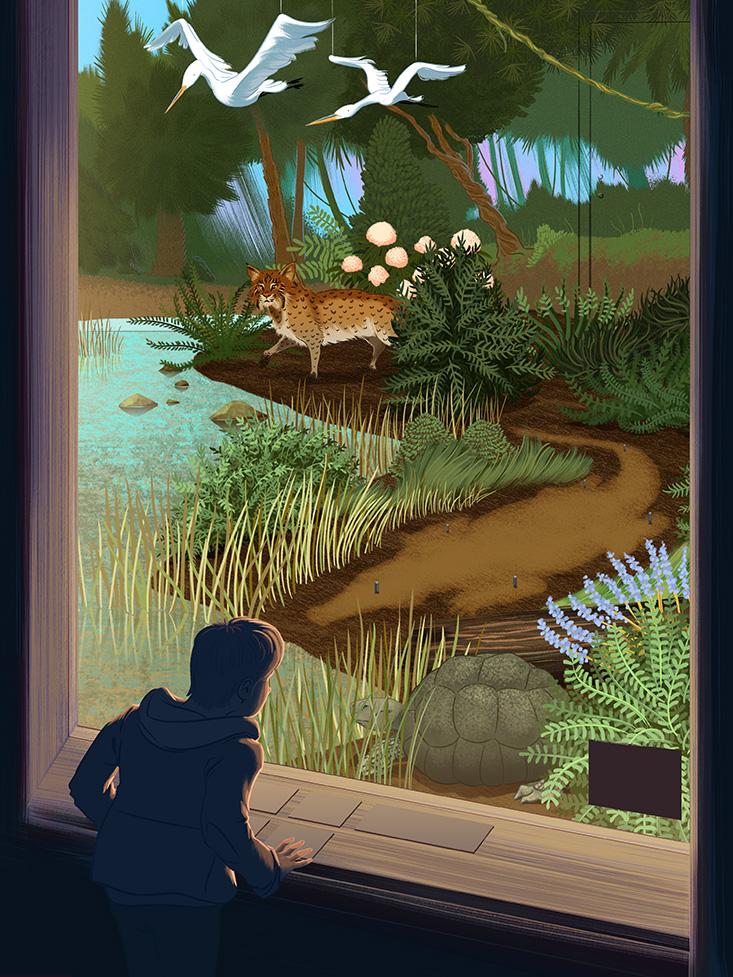
Exactly why these crocodilians persisted while others perished is not known for sure. It might boil down to the fact that lurking in water until prey gets too close is an excellent way to make a living on this planet and an ecological niche that has room for only so many. A powerful, heavily armored body does not hurt either. Whatever the reason for their resilience, it’s clear that modern crocodilians are much younger than initially suspected, that they have continued to adapt, and that they are just one set of characters in an evolutionary tale as dramatic as that of any other species. To call a crocodile a ‘living fossil,’ then, is to expose a serious lack of perspective.
“I think the term ‘living fossil’ should be retired,” Turner says. “It does little good because it is almost always based on oversimplifications. ‘Living fossils’ often are judged based on some notion of overall morphological similarity. That was the case with crocs. If you squint, these various lineages all sort of look the same, but the details are all different. It ignores how evolution works on multiple levels. I wouldn’t miss it.”
Oaks echoes him: “Overall, I think the term hurts more than it helps people’s understanding of evolution. Just because a species looks similar to fossils from many millions of years ago certainly does not mean that it has not evolved. The term ‘living fossil’ is often used in cases that are simply explained by low diversity; just because there are only one or several species that represent a taxonomic group does not mean they are evolutionarily static.”
The primordial dragon we see when we look at a crocodile is an illusion.
Our tendency to overlook the inherent dynamism of certain creatures’ evolutionary stories—to pretend that they somehow got stuck in a rut along the way—underscores our all too often self-serving perception of evolution. We like to see the fossil record as evidence of progress, of steady improvement, with humans the pinnacle of evolutionary engineering. Creatures that first evolved long ago are somehow less “advanced.” Any animal alive today that looks like those primeval beasts must be inferior to us; the only way to reconcile their existence here and now with their appearance is to act as though they were subject to a great evolutionary pause. Conversely, we consider ourselves so highly evolved that we have transcended the usual pressures of natural selection. Whereas only the fittest survive among wild animals, we can guarantee the health and safety of the vast majority; because of our supremely evolved brains—our science, technology, and medicine—we have extricated ourselves from nature. Even esteemed science communicators such as David Attenborough have perpetuated this belief.
Yet the idea that we have stopped evolving because we are so advanced is just as wrongheaded as the notion that coelacanths or crocodiles have stopped evolving because they seem so primitive. In the last 10,000 years, humans have evolved blue eyes, lactose tolerance, and malaria resistance, to name a few recent adaptations. And not all evolution leads to visible differences; sometimes it remains hidden in a creature’s genome, waiting for someone with the right tools to read it. Whether human or crocodile, whether it’s apparent or not, all living things continually evolve. The rate of evolution varies from species to species and circumstance to circumstance in complex ways scientists are still trying to understand, but it never comes to a standstill. The primordial dragon we see when we look at a crocodile is an illusion. Instead, we should recognize one of evolution’s greatest survivors—a compatriot of the planet every bit as modern as we are. There are no living fossils. Fossils cannot change; life must.
Ferris Jabr is a writer based in New York City. He has written for The New York Times, The New Yorker, Scientific American, Wired, New Scientist, Popular Mechanics, NOVA Next, and The Awl.
Quiz photo credits: Shutterstock, except Sea Lamprey: Jeramiah Smith/Smith Lab and Elephant Shark: Wikipedia





















